| Designation: | RG-32 Scout |
 |
|---|---|---|
| Manufacturer: | Denel Vehicle Systems - DVS | |
| Product type: | Auxiliary Vehicles | |
| Name: | Patrol Vehicle |
The RG-32 Scout armoured patrol vehicle was developed as a private venture to fill the gap between ineffective partially armoured commercial vehicles and a heavy-duty security vehicle. Typical roles include police, security, VIP and bullion transport.
In mid-1997, the TFM Defence and Security Division was taken over by Reunert Group and the former's range of products was integrated with Reumech OMC. Late in 1999 Vickers Defence Systems took over Reumech OMC and the company was renamed Vickers OMC.
Late in 2002, Alvis PLC took over Vickers Defence Systems and the latter company became known as Alvis Vickers. The South African company of Vickers OMC was part of this deal and this company was renamed Alvis OMC. Late in 2004 Alvis Plc was taken over by BAE Systems and Alvis OMC was renamed BAE Systems Land Systems OMC.
By late 2007, well over 700 Scout vehicles had been built for the home and export markets with first production models being in the 4 × 2 configuration with the 4 × 4 model entering production in 1995. Within South Africa, the RG-32 Scout is only found in service in the private sector. It is not used by the South African National Defence Force or the South Africa Police.
The UN High Commission for Refugees procured 27 RG-32 Scouts for use in Georgia and Burundi.
A number of companies in South Africa are now offering surplus RG-31 Scout vehicles for sale. Description
The hull of the RG-32 Scout is of all-welded steel armour construction that provides the occupants with protection against 5.56 × 45 mm ball small arms fire through 360°, although protection is also available against 7.62 × 51 mm armour-piercing small arms fire.
Versions of the RG-32 Scout are available in 4 × 4 or 4 × 2 configurations with either a petrol or diesel engine. The vehicle can be equipped with a lockable rear steel body with screen window or glazed load body canopy, or have adaptations to fit individual customer needs.
The vehicle is built upon a monocoque omni-protection capsular concept. The vehicle does not rely on a conventional chassis ladder frame to mount the cabin or automotive systems but rather the cabin assembly is built from high-alloy armour-resisting steel. The front and rear subframes accommodate the automotive driveline, suspension and steering systems.
According to the manufacturer the main benefits of this construction methodology can be summarised as:
Maximum safety of the crew from ballistic and other forms of attack by virtue of the entire envelope being an armoured capsule
High degree of safety in the event of collision or vehicle roll-over
The effect of extending the life cycle of the vehicle almost indefinitely as the body construction does not suffer any material degree of fatigue degeneration
The installation of robust beam axles and leaf sprung suspension, together with the power-assisted steering system which is conveniently accessible, due to this configuration
The crew cab consists of an all-welded, armour-protected steel shell which comprises the floor, roof, sides, front firewall and rear panel. Apertures for the doors, windows, harness, pipes and linkages are located at strategic locations with regard to structural integrity and the anti-ballistic design of the capsule.
The engine compartment is at the front, the driver is seated on the right side and has an adjustable seat with the commander to his left, with a three-man bench seat to the rear.
The doors are manufactured from heavy armour-protected steel plates and are hinged to the body by heavy-duty hinges. Each door is fitted with a heavy-duty, positive locking slam lock.
The windscreen and all door windows are manufactured of high impact-resistant laminated plate glass sections, each of which is supplied with a thick rubber surround. The glass sections are bolted into position in steel frames.
The windows of the crew cab are statically mounted and the crew cab is provided with a power air conditioning system. The roof of the cab is fitted with a tropical roof.
The subframes are bolted directly to the crew cab. They consist of welded frames and make provision for the installation of the axles and suspension, fuel tanks, load body and engine.
The front axle is a solid, reverse Elliot I-beam type with a total safe carrying capacity of 1,700 kg on the 4 × 2 version. A torsion bar assembly aids in improving road holding and steering response. On the 4 × 4 version a drive steer axle with a carrying capacity of 1,550 kg is used. The rear axle is a rigid, single reduction driven type with a gear ratio of 4.8:1 and a total safe carrying capacity of 2,200 kg.
The RG-32 Scout is fitted with a conventional heavy-duty suspension system with both front and rear axles mounted on semi-elliptic leaf springs. Each wheel station is fitted with a single double-acting hydraulic shock-absorber.
To reduce driver fatigue, the RG-32 Scout is equipped with a conventional power-assisted steering system. The vehicle is also equipped with conventional vacuum-assisted hydraulic service brakes. Each front wheel is fitted with a double hydraulic calliper acting on a disc of 280 mm diameter. The rear wheels are each fitted with drums with a diameter of 260 mm.
The crew compartment is also fitted with a tropical roof and air conditioning as an aid to crew comfort. Options include left or right hand drive and a higher level of ballistic protection. Variants
The RG-32 Scout can be fitted with a lockable rear steel body or a glazed load body canopy. If required, gun ports can also be fitted into the body area.
This is a further development of the Scout armoured patrol vehicle and was announced in late 1996. This is essentially a standard five-man Scout patrol vehicle with the following modifications:
- Larger wheels
- Modified rear body which can carry a variety of weapons
- A roof hatch with a pintle mount for 20 mm cannon, machine guns or twin grenade launchers
- Additional protection to assure survival of the crew in a single mine blast under any wheel
- Ceramic armour tiles affording protection against 7.62 mm armour-piercing ammunition
The prototype vehicle is fitted with the South African Mechem RO-107 107 mm (12-round) multiple rocket launcher covered in a separate entry.
Other armament installations include a 60 mm standard or long-range mortar, 106 mm M40 recoilless rifle, anti-tank guided missiles and a 20 mm cannon.
In 1996, the prototype of the RG-32 Military Scout was shown for the first time and this has a number of improvements to suit it for military use. These include:
- Larger 406 mm diameter wheels
- More robust axles
- Differential locks on both axles
- Adaptable military-type rear body with canopy
- More powerful six-cylinder diesel engine
- Roof-mounted hatch with gun ring
- Adaptability as a weapons carrier
- Left- or right-hand drive
- Additional mine protection including capping on weld seams and special door locks
- Manual or automatic transmission
Late in 2002 OMC unveiled a more streamlined version of the RG-32 scout called the Scout 2, which is being marketed in two versions. First a five-seat Mine Hardened Patrol Vehicle (MHPV) and second a seven-seat estate vehicle. These share a common driveline and controls and are powered by a 6-cylinder water-cooled turbocharged diesel engine coupled to an automatic transmission.
The basic Scout 2 is provided with protection from 5.56 × 45 mm ball attack and a variety of grenades, but a higher level of protection against armour-piercing attack is also available.
This has been developed specifically for military applications and details are given in a separate entry. This has so far been sold to Finland (6), Sweden (102 + 98) and United Nations (9).
|
||||||||||||||||||||||||||||||||||||
|
||||||||||||||||||||||||||||||||||||
Related Articles |
|
Finland Orders Weapon Stations for RG32M Armoured Vehicles (22.08.2012) |
|
BAE Systems Secures ˆ12.5 Million Vehicle Follow on Contract from Finland (14.06.2012) |
|
BAE Systems Delivers MOKYS Prototypes to Slovak MoD (31.01.2008) |
|
BAE Gets Overseas Orders (19.06.2005) |
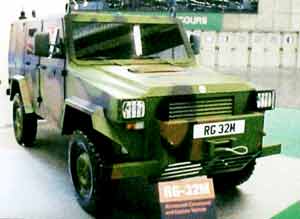 |
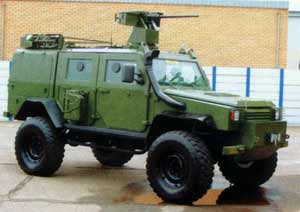 |
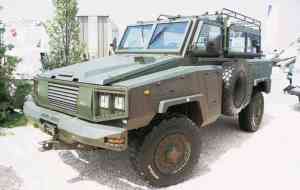 |
 |
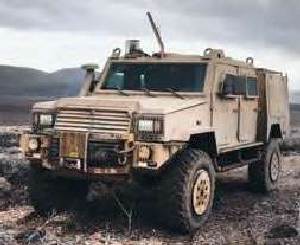 |
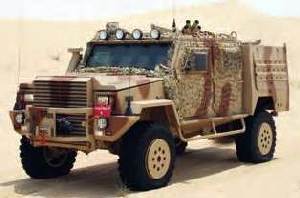 |
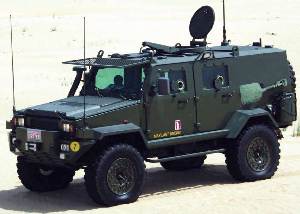 |
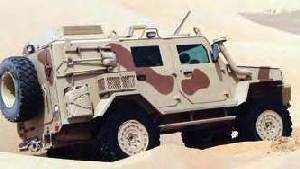 |
 |
 |
 |








